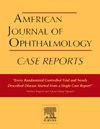Preserflo™ microshunt for the treatment of refractory childhood glaucoma: A case series study
Q3 Medicine
引用次数: 0
Abstract
Purpose
We report the outcomes of five patients with pediatric glaucoma, who were treated with Preserflo™ microshunt surgery.
Methods
This prospective study included five consecutive patients who underwent Preserflo™ microshunt surgery at the Nagoya University Hospital. The main outcome measures evaluated in this study were mean intraocular pressure (IOP), number of glaucoma medications, and best corrected visual acuity (BCVA). Paired t-tests with Bonferroni correction were used to compare the baseline and follow-up periods, where p < 0.05 was considered statistically significant.
Results
Average age at the time of surgery was 10 ± 4 years. Three patients had primary congenital glaucoma, one had Sturge-Weber syndrome, and one had juvenile open-angle glaucoma. Preoperative average IOP was 37.6 ± 4.7 mmHg. After microshunt surgery, IOP significantly decreased to 6.3 ± 1.2 mmHg in 1 day, 6.6 ± 1.7 mmHg in 1 week, 9.6 ± 6.1 mmHg in 1 month, 12.0 ± 7.4 mmHg in 3 months, 10.0 ± 5.2 mmHg in 6 months, 14.2 ± 8.7 mmHg in 9 months, and 10.5 ± 6.5 mmHg in 1 year (p < 0.01 for each paired t-test). One year postoperatively, we placed a Baerveldt glaucoma implant in case 1. No significant change was observed between the pre- and post-operative periods in BCVA. No postoperative complications, including choroidal detachment, shallow or flat anterior chamber, hypotony maculopathy, or conjunctival leak, were observed in this case series.
Conclusion
Microshunt surgery may be a useful option for treating glaucoma in pediatric patients, in whom trabeculotomy failed.
Preserflo™微分流治疗难治性儿童青光眼:病例系列研究
目的:报告5例接受Preserflo微分流手术治疗的儿童青光眼患者的预后。方法本前瞻性研究包括5例在名古屋大学医院接受Preserflo™微分流手术的患者。本研究评估的主要结局指标为平均眼压(IOP)、青光眼药物治疗次数和最佳矫正视力(BCVA)。使用配对t检验和Bonferroni校正来比较基线期和随访期,其中p <;0.05认为有统计学意义。结果手术时平均年龄为10±4岁。3例为原发性先天性青光眼,1例为斯特奇-韦伯综合征,1例为青少年开角型青光眼。术前平均眼压为37.6±4.7 mmHg。微分流术后IOP明显下降,1天6.3±1.2 mmHg, 1周6.6±1.7 mmHg, 1个月9.6±6.1 mmHg, 3个月12.0±7.4 mmHg, 6个月10.0±5.2 mmHg, 9个月14.2±8.7 mmHg, 1年10.5±6.5 mmHg (p <;配对t检验为0.01)。病例1术后一年,我们放置Baerveldt青光眼植入物。BCVA术前和术后无明显变化。在本病例系列中没有观察到术后并发症,包括脉络膜脱离、浅前房或平坦前房、黄斑低视病变或结膜渗漏。结论小梁切开术失败的儿童青光眼患者可选择微分流手术治疗。
本文章由计算机程序翻译,如有差异,请以英文原文为准。
求助全文
约1分钟内获得全文
求助全文
来源期刊

American Journal of Ophthalmology Case Reports
Medicine-Ophthalmology
CiteScore
2.40
自引率
0.00%
发文量
513
审稿时长
16 weeks
期刊介绍:
The American Journal of Ophthalmology Case Reports is a peer-reviewed, scientific publication that welcomes the submission of original, previously unpublished case report manuscripts directed to ophthalmologists and visual science specialists. The cases shall be challenging and stimulating but shall also be presented in an educational format to engage the readers as if they are working alongside with the caring clinician scientists to manage the patients. Submissions shall be clear, concise, and well-documented reports. Brief reports and case series submissions on specific themes are also very welcome.
 求助内容:
求助内容: 应助结果提醒方式:
应助结果提醒方式:


